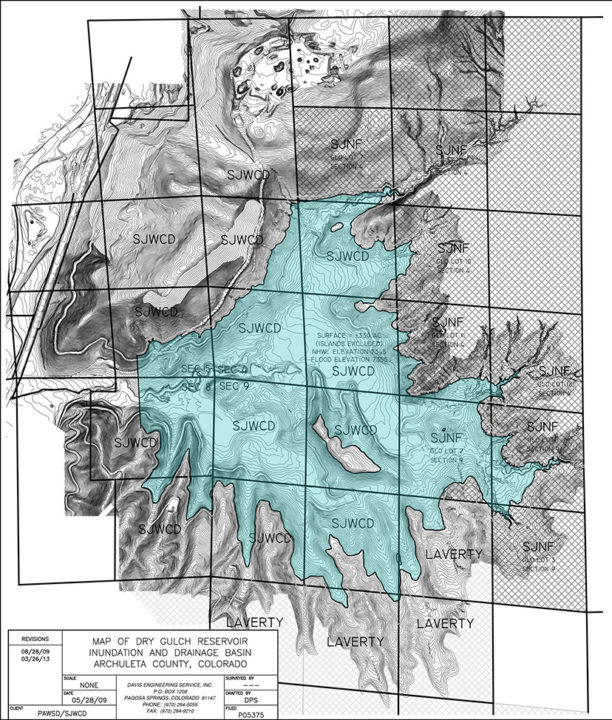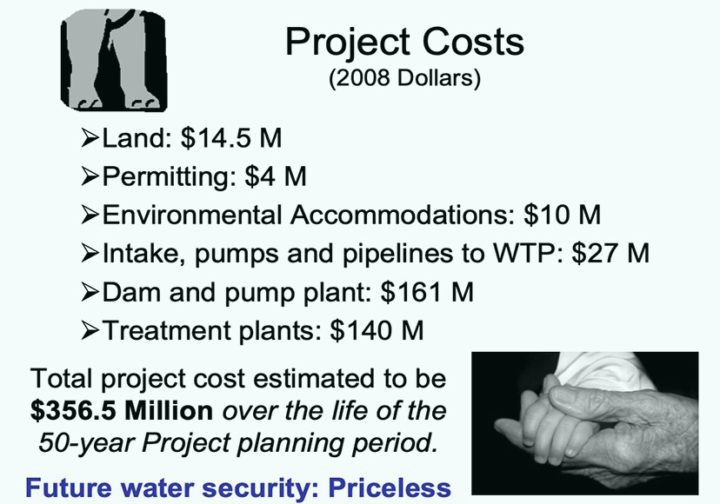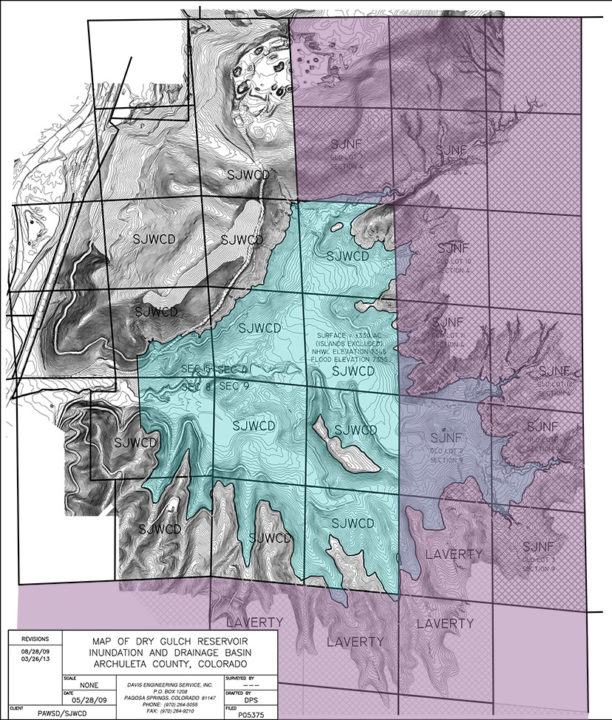I’m trying, while researching this editorial series, to better understand the complicated interface between government’s attempts to communicate, and government’s attempts to build very large projects. I suggested, on Friday, that “communications management” is a double-edged sword, which can be used just as easily to mislead people as to inform them. The people who can be misled might be ordinary taxpayers. They might also be government leaders.
It’s my humble opinion that a fair number of government leaders were misled in 2008. But maybe they wanted to be misled?
On Monday in Part Three, we shared a map that illustrates a proposed reservoir in the Dry Gulch Valley, a couple of miles north of downtown Pagosa Springs. The map appears to be a 2013 revision of an earlier map drawn in 2009.
Back in 2008, the boards of two water districts in Archuleta County — San Juan Water Conservancy District (SJWCD) and Pagosa Area Water and Sanitation District (PAWSD) — collaborated to purchase the 660-acre Running Iron Ranch for $10 million, with the idea that Archuleta County taxpayers would someday fund a new, rather large water storage reservoir on the property. (“Rather large” is in comparison to the other water reservoirs in Archuleta County, of which we currently have a half-dozen.)
The following year, in 2009, we learned that the estimated cost of a 19,000-acre-foot reservoir and related infrastructure would be approximately $357 million, to be funded by Archuleta County taxpayers.
Here’s a slide from the well-attended 2009 public PAWSD presentation about the Dry Gulch Reservoir. We can note the total cost of the project.
We also learned, later that same year, that the population growth projections PAWSD and SJWCD had used to justify their request for expanded water rights had been rejected by the Colorado Supreme Court. This court decision led SJWCD and PAWSD to negotiate water rights for a smaller reservoir, measuring up to 11,000 acre-feet. (I believe this might be the size illustrated in the 2013 map above.)
(Disclosure: I serve as a volunteer on the SJWCD board of directors, but this editorial expresses my own opinions, which are not necessarily the opinions of the board as a whole.)
But the map, shown above, does not tell the whole story.
When PAWSD and SJWCD revealed the estimated cost of the Dry Gulch reservoir project as $357 million, they understood that the 660-acre Running Iron Ranch would not accommodate an 11,000-acre-foot reservoir. In order to build a reservoir that large, PAWSD and SJWCD would need to acquire additional land from the U.S. Forest Service (“SJNF” on the map = San Juan National Forest) and from the Laverty family, an old ranching family that owns property just south of the Running Iron Ranch.
The map below shows, in pink, the property that was not part of the Running Iron Ranch, and how the proposed reservoir encroaches on those additional parcels.
The water districts’ 2009 timeline indicated that this additional property, necessary for the planned reservoir — perhaps 400 additional acres? — would be purchased in 2010. It’s now 2022, and none of the additional land has been purchased. This lack of forward motion on the project can be attributed (if we like) to the fact that, since 2010, every board member elected or appointed to the PAWSD board of directors has been philosophically opposed to asking local taxpayers to fund the Dry Gulch Reservoir.
In a very real sense, this reservoir project has been in a holding pattern for 12 years.
In 2015, PAWSD and SJWCD negotiated a new loan agreement with CWCB. That agreement assigns the job of finding the money for the reservoir to the San Juan Water Conservancy District, while PAWSD assumes responsibility for paying back its $9 million CWCB loan — and also, for paying back the $1 million CWCB grant awarded to SJWCD, if the reservoir is never built. This means the PAWSD customers, who comprise about 75% of the people living in Archuleta County, are on the hook for a $10 million debt for a reservoir that might never get built.
But all is not lost. PAWSD still owns a 660-acre ranch which was recently appraised at about $4.6 million. (The map above implies that the Running Iron Ranch is owned by “SJWCD”, but the 2015 loan agreement essentially assigns all of the property ownership, and financial obligations, to PAWSD.)
Since 2015, SJWCD has been tasked with finding partners (other than Archuleta County taxpayers?) who would like to help finance an 11,000-acre-foot reservoir — but so far, without success.
More recently, SJWCD has been busy with other concerns.
I shared, earlier in this editorial series, five key goals that the SJWCD board hopes Project Resource Studio, a “strategic communications firm” based in Carbondale, can help move forward. PRS has not yet signed a contract with SJWCD, nor has the exact scope of their work been defined. But the general idea, all along, has been to increase the level of communication between the SJWCD board and the SJWCD taxpayers… in particular, about the following goals…
- Determining the water needs (agricultural, municipal, environmental, and recreational) of the District, and how the [Dry Gulch Reservoir] and other projects might meet those needs.
- Education of the community at large regarding critical water issues that face the District, the Southwest Basin of Colorado, and the Colorado River Basin and its tributaries.
- Conservation of our limited water resources through continued existing programs and initiation of new programs.
- Ensuring the financial health and viability of the District through cost-effective asset management including, but not limited to the District’s water rights and collaboration with existing and new partners.
- Establish a reputation of operational excellence through communication both internally and externally with partners and the general public.
The first goal in this list, concerning the Dry Gulch Reservoir, might be best handled by an engineering firm. The SJWCD board had similar research done last year by Lakewood-based Wilson Water Group, and the board was, I think, pleased with the results of that study. It’s quite possible Erin Wilson and her team will be tasked with taking a harder and deeper look at the Dry Gulch Reservoir project this year.
Goal Number 2 might be part of the work handed to Project Resource Studio.
Also, Goal Number 5.
Especially, Goal Number 5. If there are government entities in Pagosa Springs that could benefit from establishing a “reputation of operational excellence”, SJWCD would be near the top of the list. And apparently, Project Resource Studio specializes in communications…



